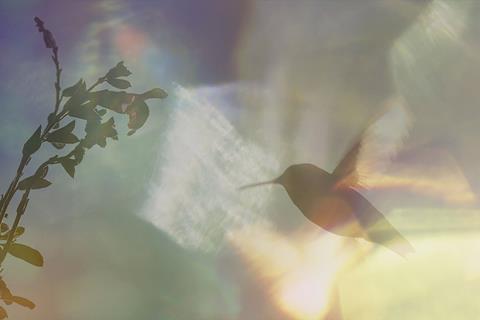
Director/Screenplay: Sally Aitken. Australia. 2024, 93 minutes.
The Los Angeles hummingbird is a tiny, incredibly fragile little creature, barely larger than a bumblebee, with the bright eyes of a pinhead and a beak as thin as a needle. But as far as Terry Massea is concerned, they punch above their weight. Massea, author of the best-selling memoir Fastest Things On Wings, has dedicated her life to rehabilitating hummingbirds in need and dreamed of being the subject of a documentary. Warm, knowledgeable, and a little quirky. But the stars of the film are undoubtedly the birds, captured to breathtaking effect in slow-motion macro photography.
The birds are definitely the stars of this movie.
There are clear similarities between the film, which debuts at CPH:DOX after screenings at Sundance, SXSW, and Thessaloniki, and director Sally Aitken’s previous work. Playing with Sharks: The Story of Valerie Taylor. Both feature a National Geographic Office-friendly combination of stunning wildlife photography and driven, passionate women who are committed to spreading the message about specific creatures. The gorgeous photography here – the bird appears to be hanging in the air, defiantly making eye contact with the camera – is rewarding viewing on the big screen. Still, the film’s life-affirming themes – Massea’s selflessness and empathy, her urge to make a positive difference one little bird at a time – could work just as well in a streaming release.
It’s a subject that could easily veer into naive sentimentality, and this movie at times tries to do so. The scores can be small arches, and the nest-like details crocheted by volunteers (according to one knitter, they are unpaid because they are valuable, not because they are worthless) are almost offensive. I feel comfortable. But for hummingbird rescuers, sentimentality is a rare luxury.
Mathea knows these tiny birds to be warriors, clowns, stunt flyers and ruthless competitors for resources, and has fielded more than 20,000 calls to the hummingbird hotline in nearly 18 years of rescue work. It is estimated that this has occurred. She names the birds brought in to her care. We came across a pair of chicks the size of a thimble and named them the “Sydney Twins” (after the rescuer who dropped the birds). Cactus is named after the thorns on the plant that injured her. A sugar baby whose wings were covered in sugar solution. such as raisins. Not everyone will survive. Massea solemnly buries the corpse, which shines like paper, with flowers on the tree. She tries not to get too attached to birds that have a low chance of survival, but she says each failure hurts her deeply.
This film raises several questions: Who is this woman? Where does her relentless sense of purpose come from? How does she fund this expensive bird rescue effort, which takes up every waking moment throughout the spring and summer? Not everything is solved, though. The film respectfully guides Ms. Massea into the personal details of extreme childhood abuse. She still clearly feels uncomfortable talking about this.
When Mathea recalls her marriage to her late husband, Frank, happier memories come back to her. Massea said she feels her husband is with her in spirit as she works to soothe and revive the wounded and broken birds. And even if the home-spun bird-based wisdom starts to get a little repetitive, the thrill of seeing extraordinary footage of these shimmering, iridescent, physics-defying birds never gets old. there is not.
Production company: WildBear Entertainment, Dogwoof
Overseas sales: Dogwoof oli@dogwoof.com;
Producer: Bettina Dalton, Oli Harbottle, Anna Godas
Cinematography: Nathan Barlow, Dan Freen, Ann Plumb
Editing: Tania Nehme
Music: Caitlin Yeo


